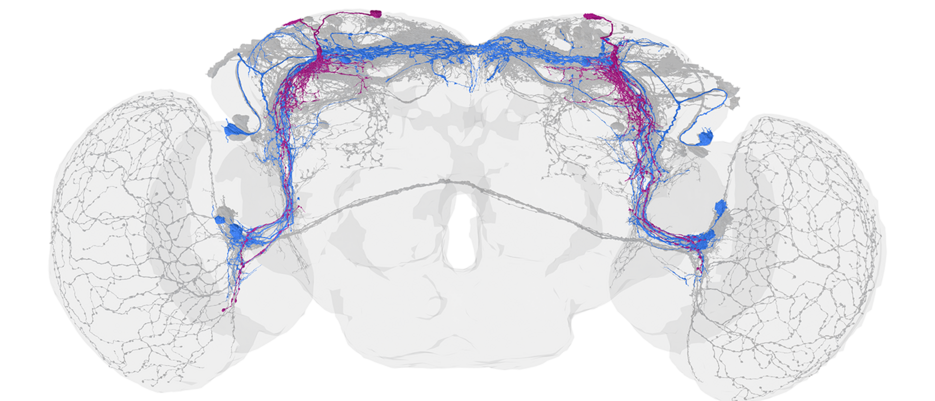A tiny neural network is sufficient to control the daily rhythm of the fruit fly, Drosophila melanogaster. Researchers at the University of Würzburg have shown that only four specialized nerve cells are necessary to drive the animals' endogenous clock.

Almost all living creatures have an endogenous clock that enables them to adapt their behavior and body functions to the natural rhythm of day and night. This so-called circadian rhythm is controlled by a complex network of specialized nerve cells. In the fruit fly, a key model organism for chronobiology, this clock network consists of around 240 neurons. By comparison, tens of thousands of these cells are found in mammals, including humans.
This complexity makes deciphering the exact functioning of the pacemaker challenging. The way these cells interact, and which cells are in control of the network, has therefore been the subject of an ongoing debate for a long time. Until recently, chronobiologists assumed that certain neurons located on the sides of the brain act as the main pacemaker, synchronizing the entire system. However, a new study shows that time measurement is much more based on a small group of various clock neurons, and that other neurons in this group can also take on the function of the main pacemaker.
The study was conducted by a research team from the Chair for Neurobiology and Genetics at Julius-Maximilians-Universität Würzburg (JMU), led by Prof. Charlotte Förster, Senior Professor for Chronobiology. The first author is Dr. Nils Reinhard, a research associate at the Chair. The team has now published the results in the journal PNAS - Proceedings of the National Academy of Sciences.
Less is More: A Core Circuit as a Pacemaker
To understand the basic principles of the clock network, the research team pursued a simple strategy: it examined a radically simplified system. "In our experiment, we manipulated the endogenous clock so that it was active only in a tiny group of four specific neurons, two of which are located in each hemisphere of the brain", explains Nils Reinhard. The circadian clock of the fly's remaining 236 clock neurons was genetically "silenced", meaning that they no longer had a functioning molecular clock.
The result was astonishing: "These four neurons alone were sufficient to maintain the fly's basal activity rhythm", says Reinhard. In fact, despite this drastic reduction, the animals exhibited their typical behavior, with one phase of activity in the morning and one in the evening. This behavior persisted even in the absence of external environmental influences. According to the scientists involved, this result shakes the foundations of the previous model, because the supposed main pacemakers of the clock network did not play an active role as timekeepers in this decisive experiment.
The researchers also identified the exact signaling pathways used by these four clock neurons to communicate their time information. The neurons use two different chemical messengers for morning and evening activity:
- Morning activity: The neurons use the neuropeptide CCHamide-1 (CCHa1).
- Evening activity: This is controlled by the classic neurotransmitter glutamate.
Experiments conducted by the Würzburg research team show that this minimal circuit possesses all the necessary tools to orchestrate the basal circadian rhythm. The neurons belonging to this minimal network appear to be deeply rooted in the animal's developmental history.
A Blueprint from Early Development
Crucial insights into the functioning of complex neural systems often stem from developmental biology. This was also the case in this study: the analysis showed that the four neurons examined are part of a network of only 18 neurons that is already fully formed in the larval stage of the fly. These early-born nerve cells remain into adulthood.
The researchers drew a key conclusion from this: "This minimal network forms a kind of 'core clock' that is established very early on and is sufficient to generate the fundamental circadian rhythms in adult flies," says Nils Reinhard.
The many additional clock neurons that are added in later stages of development probably fine-tune this core clock by integrating external environmental stimuli and modulating the minimal network. They enable adult flies to adapt their behavior flexibly to more complex environmental conditions, such as seasonal changes in day length.
Bridging the Gap Between Two Competing Models
The study thus bridges the gap between two previously competing models by showing that the circadian clock has both a clear hierarchy with a main pacemaker as well as flexible network-like properties for adaptation. According to Nils Reinhard, this principle of a core clock that is expanded by additional modulation could be a universal organizational principle of biological time measurement.
This work is basic research. Its findings help to understand the fundamental principles by which clock networks are organized and function. The observation that the complexity of the endogenous clock increases during development is not an isolated case. An increase in clock neurons has also been observed in other insects, such as bees. There are even parallels in mammals: during puberty, new neurons are added to the clock center in the brain. Therefore, the model of a "core clock" that gradually expands could also be applied to other organisms.
Original Publication
A functional clock in only two dorsal clock neurons is sufficient to restore the basal circadian activity pattern of Drosophila melanogaster. Nils Reinhard, Enrico Bertolini, Takuya Kuwahara, Manabu Sekiguchi, Dirk Rieger, Weihua Li, Paul H. Taghert, Taishi Yoshii, Charlotte Helfrich-Förster. PNAS, https://doi.org/10.1073/pnas.2506164122
Contact
Nils Reinhard, Department of Neurobiology and Genetics






